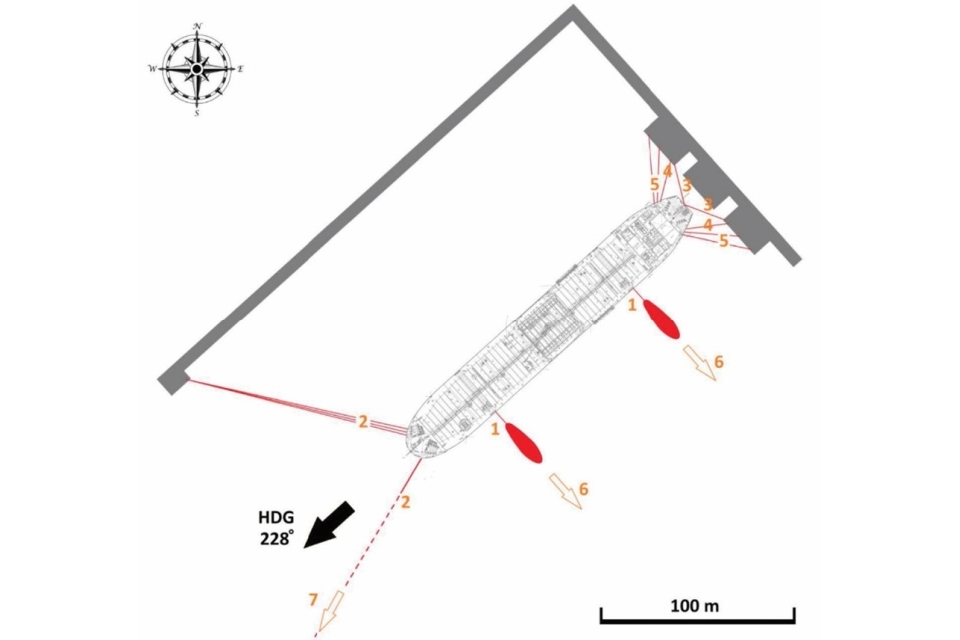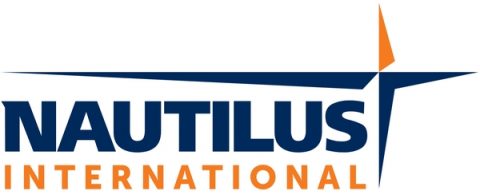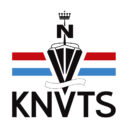Acute situational awareness around lines under tension is a critical attribute to avoid bad consequences. The Nautical Institute gives this advice in its latest Mars Report in which a stern line snapped, killing a crew member on impact.
The Nautical Institute gathers reports of maritime accidents and near-misses. It then publishes these so-called Mars Reports (anonymously) to prevent other accidents from happening. A summary of this incident:
A tanker in ballast was departing berth under pilotage with the assistance of two tugs on the port side.
The vessel was berthed “Mediterranean style”, with lines running astern to the pier and to starboard on another pier in combination with an anchor on the port side, as shown in the diagram.
The master and the pilot agreed on the unberthing sequence as follows:
- Both tug boats to be secured port side fore/aft.
- The three mooring lines from the starboard side forecastle deck to be released and the anchor to be engaged.
- The two mooring lines not under tension at the aft bitts to be released from the pier and collected through the stern centre chock.
- The two aftermost ropes to be released and collected on their drums.
- The four remaining ropes aft (two starboard and two port) to be released and collected on their drums.
- Both tug boats to pull the vessel sideways to clear her from the pier.
- Heave up the anchor.
When the three lines forward on the starboard side were released and brought on board (step 2 in the plan), the vessel began to yaw to port due to a light breeze on the starboard bow. This may have caused some consternation on the bridge. Having no view of the afterdeck, the master asked about the distance of the vessel’s stern from the berth. The officer replied it was about seven metres.
The master then requested the officer astern to engage all six remaining lines (three from each side) and bring them on board. Meanwhile, the two tugboats on the port side were already beginning to pull the vessel to port. With so many lines aft to bring in at once, the operation was not easy at the aft mooring station. One line to starboard remained taut as the others were being brought aboard.
Before the tension could be released, the line parted and whiplashed on deck. The end of the broken line hit a crew member on the back and he collapsed. Despite resuscitation efforts both onboard and later on shore, the victim succumbed to his injuries.
Also read: Towline pennant failure destroys tug wheelhouse window
Investigation findings
The official investigation found, among other things, that the stern line had probably failed at a tension that was less than the indicated amount on the Test Certificate, even though it was in good condition. Upon further investigation the Test Certificate was found to be non-authentic.
Also read: ‘Treat mooring lines as you would a loaded gun’
Advice from The Nautical Institute
- Good plans can quickly fall to pieces if there is miscommunication or a change in planned sequence. In this case, the aft mooring team was overwhelmed, as steps 4 and 5 of the original plan were combined into a single operation, and the tugboats started to pull too early.
- Acute situational awareness around lines under tension is a critical attribute to avoid bad consequences at mooring stations. Crew should be aware of snapback risks and have training on how to predict snapback areas depending on where a line may fail.
- Non-authentic documentation is not easy to spot. Efforts should be made to use credible suppliers and transparent supply chains.
Also read: Nautical Institute: Stay out of the ‘line of fire’ when working with mooring lines
Mars Reports
This accident was covered in the Mars Reports, originally published as Mars 202322, that are part of Report Number 367. A selection of this Mars Report was also published in SWZ|Maritime’s June 2023 issue. The Nautical Institute compiles these reports to help prevent maritime accidents. That is why they are also published (in full) on SWZ|Maritime’s website.
More reports are needed to keep the scheme interesting and informative. All reports are read only by the Mars coordinator and are treated in the strictest confidence. To submit a report, please use the Mars report form.








